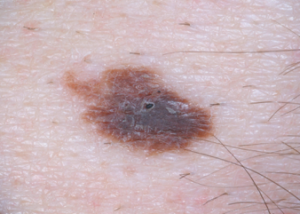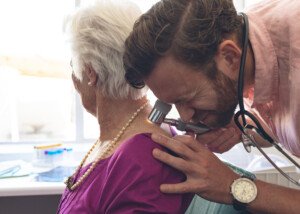
So you’re scared like sh** that your tiny new mole is an early melanoma because you read that older people are not supposed to get new moles!
So what REALLY is the truth, or at least, the most accurate conjecture, when it comes to this question:
How dangerous are new moles in older age?
But here’s another question: Just how much data is out there about this?
“Minimal,” says Dr. Jennifer Gordon, who is board certified by the American Board of Dermatology; she practices at Westlake Dermatology located in Austin, Texas.
MINIMAL. Yes, you can tell it’s minimal because if you’ve spent any time running this topic down on Google, you would have quickly realized that most of the other medical sites out there have taken information from the same source (unknown) and just reworded it a little.
What does that “minimal” data reveal about new moles in older age?
“The data shows an increasing risk of melanoma with age, and in general, adults (over 30) make fewer acquired nevi,” says Dr. Gordon.
“Nevi” (pronounced Levi) is plural for nevus (pronounced knee-vus). A nevus is the medical term for a mole.
“This combination [of data] suggests that any acquired nevi over the age of 30 should be routinely checked because there is a higher chance of a new nevus being atypical simply because of the math,” continues Dr. Gordon.
THE MATH
• As people age, they acquire fewer new nevi.
• The older a person is, the more likely a new mole, as well as pre-existing nevi dating back to childhood, will become cancerous.
• When this higher likelihood is combined into the equation of fewer new moles in older age, the relative proportion of new moles in older age that become melanoma creates the illusion that new moles in older people are cause for grave alarm.
“So there is some alarm, but it does not mean that any new mole after the age of 50 is dangerous.
“We know that in general, melanoma arises from a previous mole in about one-third of the cases; the other two-thirds of cases arise spontaneously.”
An “atypical” mole is not melanoma.
What atypical means is that the mole is comprised of pigmented cells that are not the same as the cells of typical nevi. Think of these cells as being a little “off.”
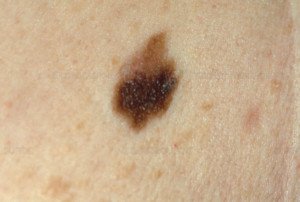
Atypical mole. Biophoto Associates/Science Source
Because of that, they are more likely than their typical counterparts to ever become malignant.
An atypical nevus is not destined to turn cancerous; it’s just at a higher risk, that’s all.
This rule applies to younger people as well as people in older age who acquire a new mole.
Dr. Gordon adds, “Acquired nevi peak in the second to third decade and decrease in the seventh to ninth.”
This means that a 90-year-old could actually get a new mole that never becomes a melanoma.
Of course, that 90-year-old will, from a statistical standpoint, be dead before any new benign mole ever begins morphing into melanoma.
But even in a 70-year-old, there IS a such thing as a newly developed mole that remains benign right up to this person’s 95th birthday—or however long they live.
“Nevogenesis can occur throughout life,” says Dr. Gordon.
Wow, you’d never think this, based on all those alarming, recycled narratives on other sites about new moles in older age.
Some of these sites have you thinking that you’re absolutely NOT supposed to get a new mole after a certain age!
“Nevogenesis” means development of new moles.
“In general, any new pigmented lesion should be evaluated and monitored by your dermatologist,” says Dr. Gordon.
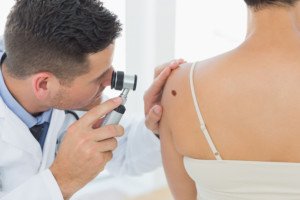
Shutterstock/wavebreakmedia
This rule has more to do with the fact that a melanoma can look like a normal mole in its early stages, than how old the person is when they discover the new spot.
In other words, if a 23-year-old discovers a newly developing “mole” on his chest, for instance, he should have a dermatologist examine it to make sure it’s not actually a melanoma.
But of course, a much older person with the same experience should have the spot examined just as well.
And if it’s determined it’s benign, this is no shock; remember, new moles can arise in people as old as 95, but all new moles (or what appear to be) in adults of any age should be checked by a dermatologist just to be sure — and included in monthly self-exams of the skin.
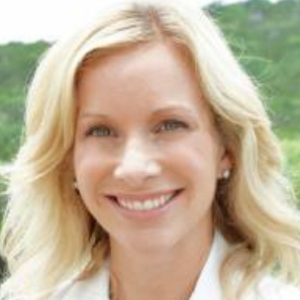
Dr. Gordon’s interests include medical dermatology, particularly the treatment and prevention of melanoma and other skin cancers in athletes. For 2016, 2017 and 2018 Texas Monthly Magazine selected her as one of the Texas Super Doctors Rising Stars.
 Lorra Garrick has been covering medical, fitness and cybersecurity topics for many years, having written thousands of articles for print magazines and websites, including as a ghostwriter. She’s also a former ACE-certified personal trainer.
Lorra Garrick has been covering medical, fitness and cybersecurity topics for many years, having written thousands of articles for print magazines and websites, including as a ghostwriter. She’s also a former ACE-certified personal trainer.
.

